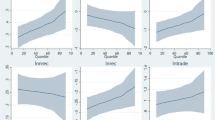Abstract
The slow growth of the Chinese economy has led to a reduced number of environmental regulations. This study aims to establish whether China’s “new normal” economy can stimulate environment-biased technological progress to improve industrial land-use efficiency. First, we set up a two-sector theoretical model where in the new normal is treated as an exogenous variable to analyze the combined effects of technological progress, industrial land-use efficiency, and environmental regulations. Then, we establish a multi-index and multi-indicator constitutive equation, in which environment-biased technological progress is taken as an intermediate variable. The results show that the effects of weak environmental regulations on environment-biased technological progress are not significant and that China’s new normal economy can stimulate the progress of clean technology, thereby improving industrial land-use efficiency. Finally, foreign direct investment restricts the improvement of industrial land-use efficiency.
Similar content being viewed by others
References
Acemoglu, D. (2003). Labor- and capital-augmenting technical change. Journal of the European Economic Association, 1, 1–37.
Acemoglu, D., Aghion, P., Bursztyn, L., & Hemous, D. (2012). The environment and directed technical change. American Economic Review, 102, 131–166.
Acemoglu, D., Gancia, G., & Zilibotti, F. (2015). Offshoring and directed technical change. American Economic Journal: Macroeconomics, 7, 84–122.
Aghion, P., Dechezlepertre, A., Hemous, D., Martin, R., & Van Reenen, J. (2012). Carbon taxes, path dependence and directed technical change: Evidence from the auto industry (pp. 1–46). NBER working paper w18596.
Aiken, D. V., Färe, R., Grosskopf, S., & Pasurka, C. A, Jr. (2009). Pollution abatement and productivity growth: Evidence from Germany, Japan, the Netherlands, and the United States. Environmental and Resource Economics, 44, 11–28.
Antweiler, W., Copeland, B., & Taylor, S. (2001). Is free trade good for the environment? American Economic Review, 91, 877–908.
Baskent, E. Z., & Kadiogullari, A. I. (2007). Spatial and temporal dynamics of land use pattern in Turkey: A case study in Inegöl. Landscape and Urban Planning, 81, 316–327.
Cesaroni, F., & Arduini, R. (2001). Environmental technology in the European chemical industry. LEM working paper.
Chambers, R. G., Färe, R., & Grosskopf, S. (1996). Productivity growth in APEC countries. Pacific Economic Review, 1, 181–190.
Dong, Z. Q., Guo, Y. T., Wang, L. H., & Dai, J. (2013). The direction of technical change: A study based on inter-provincial panel data of China. Asian Journal of Technology Innovation, 21, 317–333.
Giles, D. E. A., & Tedds, L. M. (2002). Modeling the hidden economy and the tax-gap in New Zealand. Empirical Economics, 24, 621–640.
Grossman, G. M., & Krueger, A. B. (1991). Environmental impacts of a North American free trade agreement. NBER working paper, no. 3914.
Grossman, G. M., & Krueger, A. B. (1995). Economic growth and the environment. Quarterly Journal of Economics, 46, 147–162.
Hourcade, J. C., Pottier, A., & Espagne, E. (2011). The environment and directed technical change: Comment (pp. 1–16). CIRED working paper.
Liu, S., & Jiang, X. (2005). Financial risks of land financing by local governments—Case study of a developed area in East China. China Land Sciences, 5, 3–9.
Liu, W. B., Zhou, Z. B., Liu, D. B., & Xiao, H. L. (2015). Estimation of portfolio efficiency via DEA. Omega, 52, 107–118.
Meadows, J., Emtage, N., & Herbohn, J. (2014). Engaging Australian small-scale lifestyle landowners in natural resource management programmes—Perceptions, past experiences and policy implications. Land Use Policy, 36, 618–627.
Naughton, B. (1999). How much can regional integration do to unify China’s market?. University of California at San Diego, Mimeo.
Oh, D. H. (2010). A global Malmquist of efficiency in data envelopment analysis. European Journal of Operational Research, 130, 498–509.
Popp, D. (2004). ENTICE: Endogenous technological change in the DICE model of global warming. Journal of Environmental Economics and Management, 48, 742–768.
Popp, D., Newell, R. G., & Jaffe, A. B. (2009). Energy, the environment, and technological change. NBER working paper, no. 14832.
Serneels, S., & Lambin, E. F. (2001). Proximate causes of land-use change in Narok District, Kenya: A spatial statistical model. Agriculture, Ecosystems & Environment, 85, 65–81.
Serra, P., Pons, X., & Saurí, D. (2008). Land-cover and land-use change in a Mediterranean landscape: A spatial analysis of driving forces integrating biophysical and human factors. Applied Geography, 28, 189–209.
Song, M. L., & Wang, S. H. (2016). Can employment structure promote environment-biased technical progress? Technological Forecasting and Social Change, doi:10.1016/j.techfore.2016.02.016.
Tennent, R., & Lockie, S. (2013). Vale Landcare: The rise and decline of community-based natural resource management in rural Australia. Journal of Environmental Planning and Management, 56, 572–587.
Wang, S. H., & Song, M. L. (2014). Review of hidden carbon emissions, trade, and labor income share in China, 2001–2011. Energy Policy, 74, 395–405.
Young, A. (2000). The razor’s edge: Distortions and incremental reform in the People’s Republic of China. Quarterly Journal of Economics, 115, 1091–1135.
Zacharias, S., Bogena, H., Samaniego, L., Mauder, M., Fuß, R., Pütz, T., et al. (2011). A network of terrestrial environmental observatories in Germany. Vadose Zone Journal, 10, 955–973.
Zhang, T. (2000). Land market forces and government’s role in sprawl: The case of China. Cities, 17, 123–135.
Acknowledgments
This work was supported by Major Projects in Philosophy and Social Science Research, Ministry of Education of The People’s Republic of China (Grant No. 14JZD031); The National Natural Science Foundation of China (Grant Nos. 71171001, 71573045, and 71471001); the China Postdoctoral Science Foundation (Grant No. 2015M570613); and The Natural Science Foundation of Shandong, China (Grant No. ZR2015PG003).
Author information
Authors and Affiliations
Corresponding author
Rights and permissions
About this article
Cite this article
Song, M., Wang, S. & Wu, K. Environment-biased technological progress and industrial land-use efficiency in China’s new normal. Ann Oper Res 268, 425–440 (2018). https://doi.org/10.1007/s10479-016-2307-0
Published:
Issue Date:
DOI: https://doi.org/10.1007/s10479-016-2307-0




